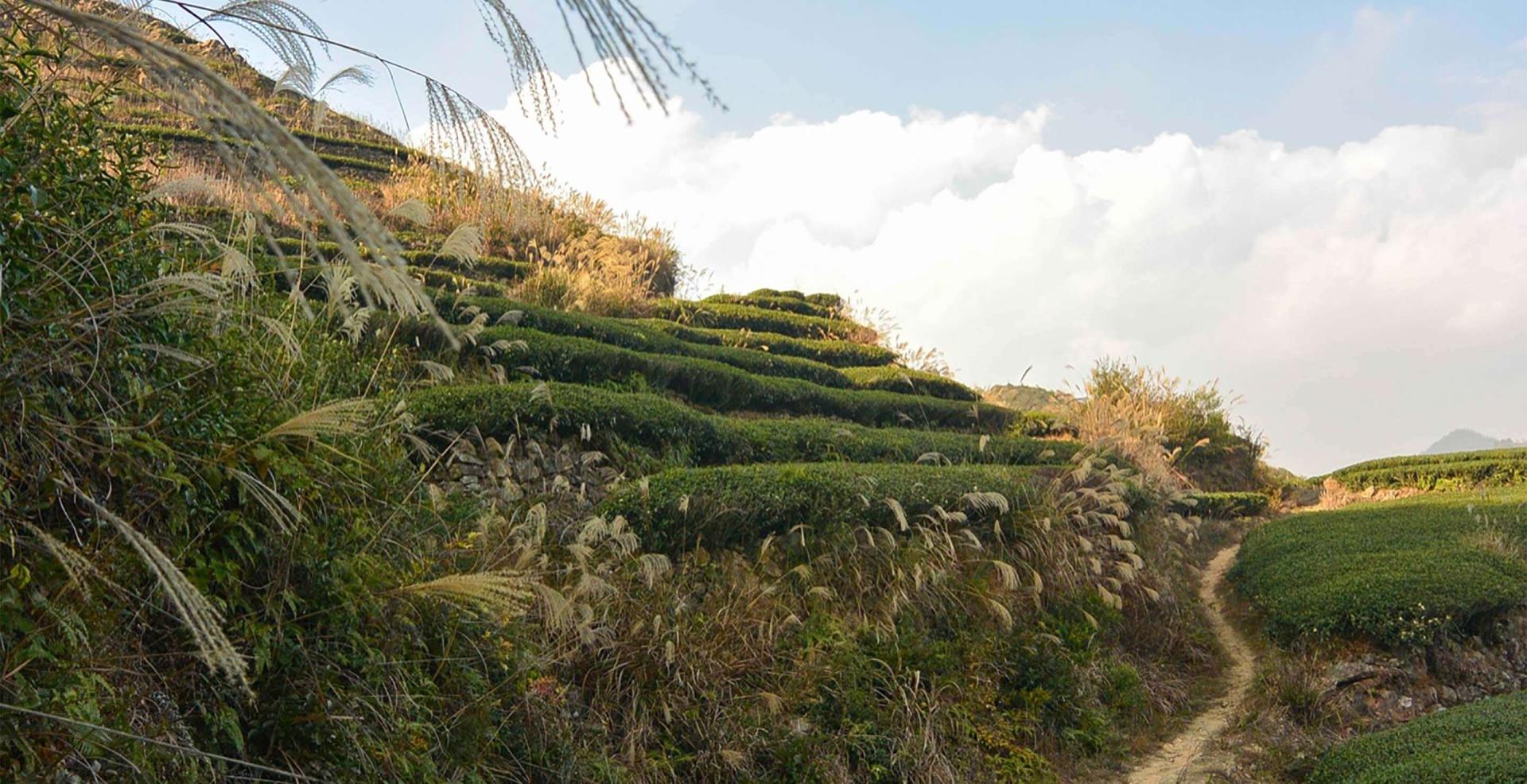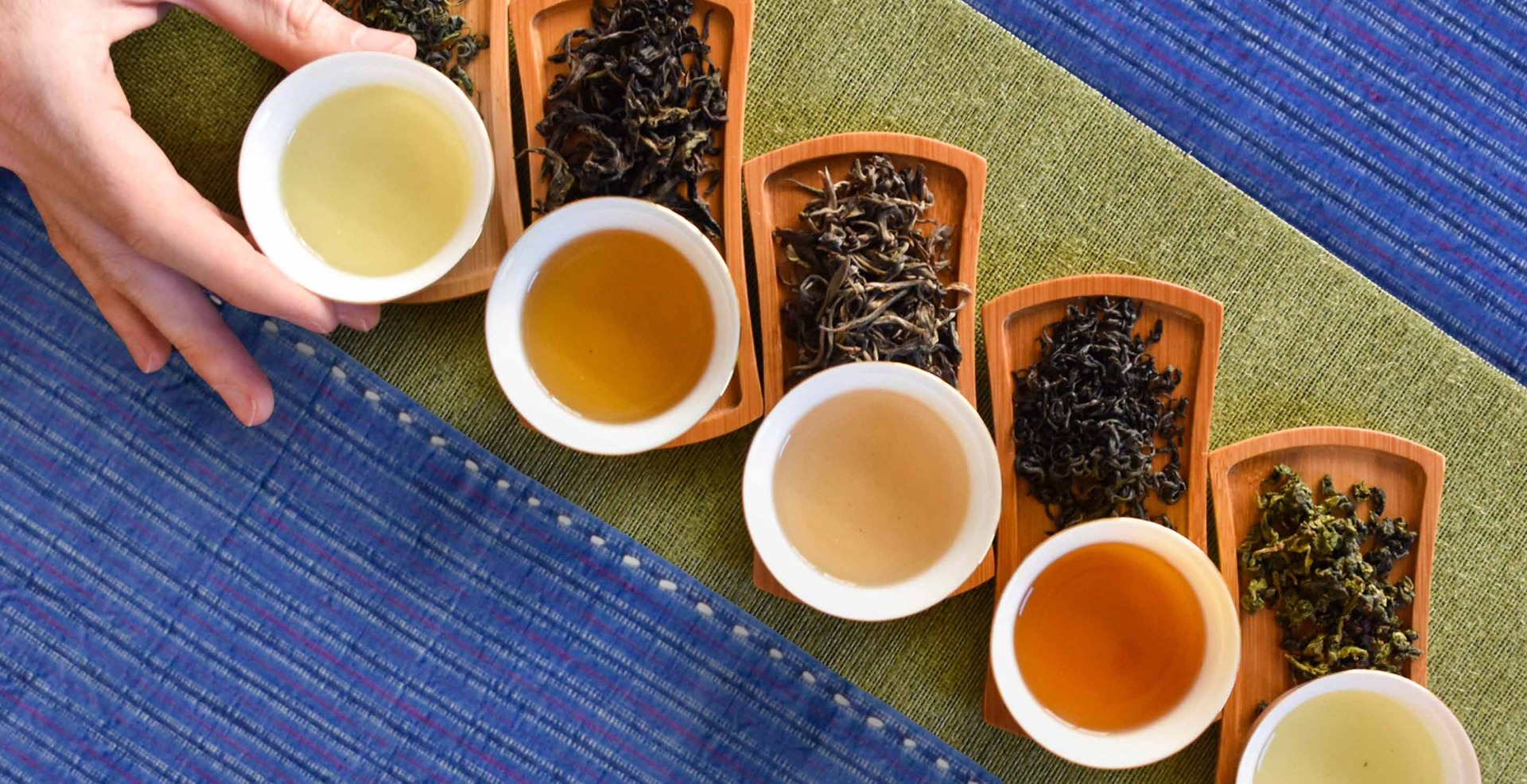Tea craft starts in the fields. To really appreciate how tea tastes, you need to ask: how is tea grown? Planting and farming practices make the difference between good tea and truly great tea. Although most people might not be able to visit a tea farm, you can still know your farmers - the people behind the tea!
We’ll explore the challenging work of the tea farmer, with a focus on small family farmers: from caring for the land itself to planting specific cultivars, knowing when to harvest the tea, and how to care for it along the way. By the end of this article, you’ll know why the term “tea master” truly belongs to the farmers more than anyone else.
"The term 'master' truly belongs to the farmers more than anyone else."
The Tea Plant: What Is It?
The tea plant ( Camellia sinesis ) is an evergreen that grows wild throughout the mountains of Southeast Asia. While today we refer to tea as Camellia sinesis var sinensis or var assamica, humans have had a long relationship with this special plant, referring to it as tú (荼), tê, ming (茗), chá (茶) and more.
As our relationship with the plant has grown deeper, our names have gotten more specific. In the earliest days, tea was a medicine, picked wild and steeped in boiling water, often combined with a broth of ginger, scallions, and other medicinal plants. Only later did tea develop its own domesticated agricultural practices and brewing culture.
Where is tea from?
Many places claim to be the birthplace of tea, but what country does tea come from? The plant itself is referred to in ancient Chinese, Tibetan and pre-colonial Indian literature. We also know that the oldest tea trees in the world grow wild in the mountains of Qianjiazhai in Yunnan, China.
That said, tea also grows wild across mountainous Southeast Asia - including Vietnam and Thailand, and tea is important to cultures across the world.




Where is Tea Grown?
-
• Eastern Europe, including Georgia
-
• Africa, including Kenya and Ethiopia
-
• North America, including Hawaii and the Pacific Northwest
-
• Southeast Asia, including Vietnam, Thailand and Indonesia


Tea grows all across the world. Early tea farming started in what is now China, but soon spread across southeast Asia to Japan and Korea via Buddhism as a favored meditation aid for monks. Tea did grow in India before colonialism, but widespread cultivation in large plantations took hold in order to meet European demand. Tea has become important to so many human cultures that today, growing Camellia sinensis has gone global, including:
Tea Growing Conditions
What kind of climate is best for growing tea?
According to our partners across China, tea does best in rocky, well-draining soil, shaded from excess sun, in regions with a large temperature swing between day and night, and a balanced ecosystem that keeps pests under control naturally. The most sought-after and famous teas in the world come from mountains like Wuyishan where organic agriculture is followed, natural forest cover is preserved, and mountains make for sweet spring water and misty mornings.
-
• Climate: cooler, drier subtropical regions have the best tea climatic conditions
-
• Tea Soil Type: the best soil for tea cultivation is rocky and well-draining to encourage deep roots
-
• Location: Biodiverse mountains far from development and pollution


IN THEIR OWN WORDS:
Li Xiangxi speaks about the best climate for growing tea.
How Is Tea Grown? The Tea Production Process
Growing tea plants is a multi-generational collaboration between the land, the weather and the people that requires everything to come together just right.
All truly great tea starts with responsible land practices and thoughtful farming - the kind that only happens with small family farms are incentivized by the knowledge that they will pass down their work to their children and grandchildren.
Agricultural practices like organic cultivation, and increasing forest cover and biodiversity also reduce short term yields and increase costs. This makes it difficult for farms run by factories or investors to think on the hundred-year timeframe required to make the best decisions for their tea, community, and local environment.
Planting and Growing
How does tea grow? A tea bush can propagate naturally from seed, but there can be large genetic variation in tea seeds. To ensure a specific cultivar with a specific flavor profile, usually cuttings are grafted onto root stock. This process requires tremendous care and the willingness to wait years before the plant is ready to start harvesting.
IN THEIR OWN WORDS:
Master Zhang explains the cutting and grafting process.


Where does tea grow best? Tea crop cultivation in ideal conditions does not require additional watering or the use of chemical pesticides and synthetic fertilizers. In the right environment, tea gets water from mountain springs which encourages deep roots, and insects are kept in check by birds.
IN THEIR OWN WORDS:
Master Zhang discusses the environmental factors in growing tea.
Careful field management and innovative agricultural practices can also extend tea’s reach to even more challenging growing regions, like in China’s northernmost tea growing region in Laoshan, Shandong. Even here, abundant springs and uniquely temperate weather make growing tea possible.
Unfortunately, monoculture farms planted in hot low-elevation plots rely on chemicals and irrigation, affecting the tea’s quality and health benefits.
IN THEIR OWN WORDS:
Mr. He speaks on sustainable tea cultivation
Harvesting
Harvesting tea is hard work and requires perfect timing. Delicate spring teas require picking early in the morning before the buds are exposed to excessive sunlight. On our partners’ small family farms across China, picking is done entirely by hand to ensure perfect buds and leaves, while larger factory operations may rely on machinery.
Picking by hand takes years of experience, with most small family farmers planning a hard and busy spring season and relying on help from neighbors since the work takes too much specific skill to hire out. By contrast, monoculture farms rely on flat land and heavy machinery to harvest tea.
IN THEIR OWN WORDS:
Mr. He speaks on sustainable tea cultivation
“We use beans as fertilizer - soy beans. We mash them up and mulch them. Then, we water all in here [in the greenhouse], and then we put on the cover. When it gets down to -5 of -6 degrees C, then we cover it.
To pick the tea, we have to come early for a whole month. It’s a lot of trouble to go through! Yes - so much work.
In a year, on a sixth ace like this, you can pick 380 jin (190 kg). The volume is really small. You really can’t pick too much.
Laoshan tea isn’t like the south. Their tea doesn’t get such little rain. Here, the weather is cold and dry. We have to water. The temperature isn’t high enough, so we have to cover our tea.
[On factory farms], the way they pick tea… We have to pick one at a time. They just cut the leaves in one go, and then collect them up. No expenses at all, cheap tea. [That tea] doesn’t have the same quality or texture. If you don’t work for it, it won’t grow. There is a whole school of learning to teach all this, but it hasn’t changed much in over 300 years.”
Processing


Processing tea is all about different strategies to lock in as much flavor, texture, aroma and aftertaste as possible. The best processing is still done mostly by hand in small batches. Tea farmer Zhang Rongde describes finishing tea as a process that changes depending on the weather or the hour.
-
• Step 1: Tea is picked in the fields and brought back to the workshop
-
• Step 2: Tea is either withered, oxidized or spread out for drying
-
• Step 3: Tea has heat applied to halt chemical change at the right mome
IN THEIR OWN WORDS:
Master Zhang discusses his tea processing philosophy.


Growing Different Types of Tea: What’s the Difference?
Different types of tea are defined by their finishing craft. Any picked leaves can be transformed into any type of tea, depending on the decisions made in the workshop. That said, most tea farmers know what kind of tea they want to make before they even start planting. Some varietals tend to really shine with certain finishes, or some kinds of tea call for more leaf or more bud.
IN THEIR OWN WORDS:
Li Xiangxi speaks about the best climate for growing tea.
Black Tea
Black tea is defined by intentional oxidation, and nothing else. Any tea varietal from any place can be made into black tea simply by allowing the tea to oxidize before heat is applied to stop further chemical change.
IN THEIR OWN WORDS:
Mr. He speaks on Black Tea
Green Tea
How is green tea grown and finished? Uniquely - green tea is usually picked very early when buds are at their most delicate. Green tea is only allowed to wither for a short period before it is rushed to heat-fixing. This heat fixing process locks in a green fresh flavor closer to the sensation of tasting fresh leaves from the field.
IN THEIR OWN WORDS:
Mrs. Li speaks on Dragonwell's unique growing conditions.
Oolong Tea
Oolong tea is defined by its yaoqing process of fluffing and turning the leaves throughout a long withering stage. Oolongs can be dark roasted and oxidized or green and fresh. Only the yaoqing process is required to call a tea oolong.
Pu’er Tea
Pu’er tea is traditionally made in Yunnan with assamica varietal leaf (da ye zhong). Pu’er can be divided into shu (熟, cooked) and sheng (生, raw). Pu’er is defined by the fact that it is crafted specifically to age and get better over time. Intentional fermentation happens in higher-moisture conditions and gives the tea a deep complexity.
-
• Shu pu’er is picked and fermented in a high humidity environment to speed up the process of change
-
• Sheng pu’er is allowed to change slowly over many years at a much lower humidity
-
• Pu’er traditionally skips the heat-fixing stage to encourage chemical change to continue for years to come.
White Tea
White tea is a unique style that generally skips the critical heat-fixing stage with the goal of drying out a tea with as little intervention as possible, as quickly as possible. White tea craft is all about locking in the flavor of fresh leaves from the field without transforming them through added heat.
-
• White tea is often made with da bai varietal tea
-
• White tea is finished with low or no heat with special air-circulation to dry the leaves before they oxidize
-
• White tea can be aged for deep complexity over time


Do Tea Cultivation Practices Affect Quality?


Tea is only as good as the people who produce it. Every decision around cultivation changes the flavor and health benefits of the finished leaf. It is tempting to look at tea as a commodity, but the truth is that factory-farmed tea can never compete with hand-picked hand-finished tea from small family farmers that care for their land.
Biodiverse healthy land means natural forest cover and habitats for birds that keep insects in check. It means wildflowers growing around the tea and influencing its flavor. It means sweet mountain springs and healthy roots. When tea grows in a perfect landscape, it is packed with texture, aroma and aftertaste, all while having more antioxidants and L-theanine.
Organic and fair trade is a start, but small family farms go far beyond the standards of these certifications. Knowing the stories of the families behind the tea can help you come to understand what makes your tea so special.
The best agriculture is transformative, whether it is Master Zhang working to restore the mountains above Daping Village to a zero-footprint natural state, or the He Family in Laoshan using organic agriculture to lift up the whole region.
Discover Tea That Has Been Crafted By Small Family Farms in China
How is tea grown in China by small family farmers? Growing tea is no simple process - it is a multigenerational labor of love that starts with the land itself and goes all the way through the picking and finishing process. Nobody can tell the story better than the farmers themselves, people like Master Zhou in the wild tea forests of Qianjaizhai or Li Xiangxi in the Wuyishan Ecological Preserve.
Want to try tea whose craft started in the fields? Try a tasting kit or join our farmer-curated CSA-style Tea of the month club. There’s no better way to learn than to taste the difference for yourself.
Right now, there aren’t many insects. Why aren’t there any insects? Because the winter is too cold. Most of the insects freeze.
Seasonally, there will be insects, but the birds eat them all.
Our tea here is all natural - no chemical pesticides, no. Some of it is eaten by insects but some is left, and that is what we can work with to make tea.”


 How To
How To Myths & Legends
Myths & Legends Travelogue
Travelogue Tasting Journal
Tasting Journal Talking Shop
Talking Shop Tea 101
Tea 101 Watch
Watch Teaware
Teaware News
News








Leave a Reply